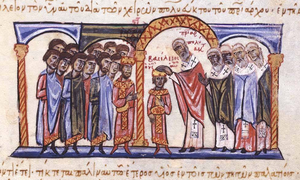
The coronation (Greek: στέψιμον, romanized: stépsimon, or στεφάνωσις, stephánosis[2]) was the main symbolic act of accession to the throne of a Byzantine emperor, co-emperor, or empress. Founded on Roman traditions of election by the Senate or acclamation by the army, the ceremony evolved over time from a relatively simple, ad hoc affair to a complex ritual.
In the 5th–6th centuries the coronation became gradually standardized, with the new emperor appearing before the people and army at the Hippodrome of Constantinople, where he was crowned and acclaimed. During the same time, religious elements, notably the presence of the Patriarch of Constantinople, became prominent in what was previously a purely military or civilian ceremony. From the early 7th century on, the coronation ceremony usually took place in a church, chiefly the Hagia Sophia, the patriarchal cathedral of Constantinople. The association of the coronation ceremony with Constantinople and the Hagia Sophia became so close that even emperors who had been proclaimed, and crowned, outside the capital as military rebels or usurpers, usually repeated their coronation in the capital once they had won power.
The ritual was apparently standardized by the end of the 8th century, and changed little afterwards. It involved the homage of the Senate, a procession to the Hagia Sophia and the distribution of largess to the people. A special coronation service was held, for which the emperor or empress to be crowned changed into coronation dress inside the church. The act of coronation was carried out by the patriarch, except when a ruling emperor crowned a co-ruler or his wife. Either before or after the act of coronation, the emperors received the acclamation of the dignitaries, the troops and the people. The main change in the ceremony was the addition of the emperor's unction in the early 13th century, likely under Western European influence, although this is disputed by scholars; and the revival of the late antique practice of carrying the emperor on a shield in the 1250s. The Byzantine coronation ritual influenced other Eastern Orthodox states, notably Russia, and is a frequent subject of Byzantine art, where rulers are shown as receiving their crown directly from Christ, the Theotokos, or angels.
- ^ Tsamakda 2002, pp. 179, 286.
- ^ ODB, "Coronation" (M. McCormick), pp. 533–534.